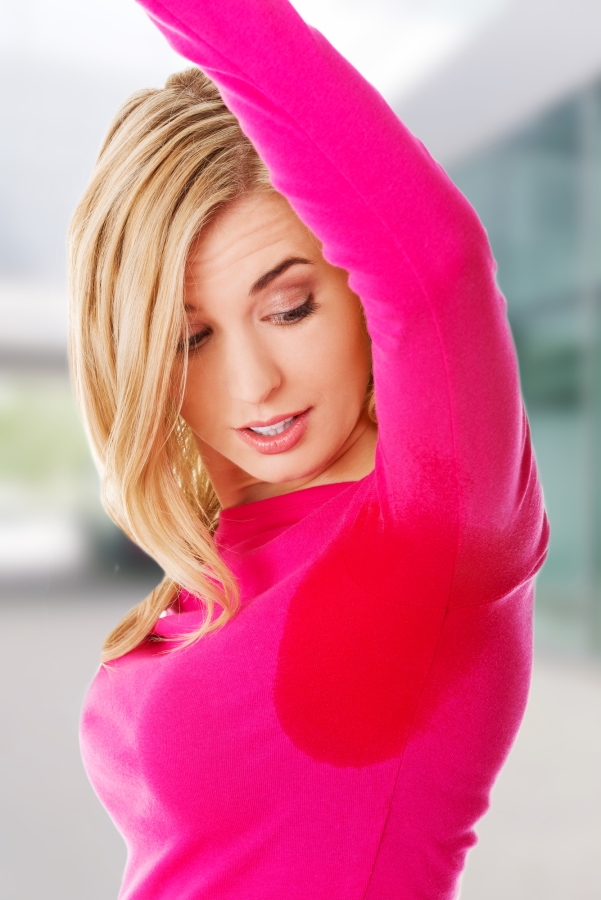Hyperhidrosis is excessive sweating. This condition happens when you sweat more than what your body needs to regulate your temperature. Hyperhidrosis is the result of your sweat glands overworking.


Sweat is an odorless fluid released from your eccrine glands (sweat glands). Sweat’s job is to help regulate your body temperature and prevent overheating. You have eccrine glands in your skin. Sweat moves from your glands through tubes called ducts until it reaches the surface of your skin. Once sweat leaves the ducts, it changes from a liquid to a gas and disappears from your skin (evaporates) to cool down your body.
Hyperhidrosis is common. Research suggests that an estimated 3% of adults in the United States between ages 20 and 60 have hyperhidrosis.
Sweat comes from eccrine glands, which exist in the skin throughout your body. You have the most eccrine glands in your:
Armpits or underarms (axillary hyperhidrosis).

Soles of your feet (plantar hyperhidrosis)

Palms of your hands (palmar hyperhidrosis).

Forehead and cheeks (craniofacial hyperhidrosis).

Genitals.

Lower back.

The most common location on your body to experience excessive sweating is the palms of your hands.
Cause:
Overactive sweat glands cause hyperhidrosis. Your eccrine glands (sweat glands) create sweat to cool down your body when you get hot. This process activates when you exercise or if you’re nervous. If you have hyperhidrosis, your eccrine glands activate and produce sweat more often than when your body is too hot. You may experience sweating at random times of the day when there isn’t something like an activity or emotion causing your glands to produce sweat. Research is ongoing to learn more about why your glands make too much sweat.
There are two types of hyperhidrosis:
Primary focal hyperhidrosis: Focal hyperhidrosis is a chronic skin condition. A genetic change (mutation) causes this condition. You can inherit it from your biological family. This is the most common type of hyperhidrosis. It usually affects your armpits, hands, feet and face. It tends to start before age 25.
Secondary generalized hyperhidrosis: Generalized hyperhidrosis is excessive sweating caused by an underlying medical condition or it’s a side effect of a medication. Some examples include diabetes and Parkinson’s disease and medications, such as naproxen (Aleve®). Generalized hyperhidrosis may cause you to sweat while sleeping.
Triggers that cause sweating:
- Certain emotions like stress, anxiety, fear or nervousness.
- Warm temperatures or humidity.
- Exercise or physical activity.
- Wetness on your skin.
- Damp clothing.
- Beads of fluid dripping from your cheeks or forehead.
- Certain foods and beverages, like spicy foods, fatty foods, sugary and salty foods, and foods with high levels of protein. Beverage examples include caffeinated beverages (coffee) and alcohol.
Over time, hyperhidrosis can lead to the following symptoms:
- Itching and inflammation when sweat irritates your skin.
- Body odor, which occurs when bacteria on your skin mixes with sweat particles.
- Cracked or peeling skin on your feet.
- Hyperhidrosis symptoms can range in severity. You may have minor symptoms that come and go or you may have constant symptoms that have an impact on your day-to-day activities.
- Medications that cause sweating
Certain medications can cause sweating as a side effect, including but not limited to:
- Albuterol (Proventil®).
- Bupropion (Wellbutrin®).
- Hydrocodone.
- Insulin (Humulin® R, Novolin® R).
- Levothyroxine.
- Lisinopril.
- Naproxen (Aleve®).
- Omeprazole (Prilosec®).
- Sertraline (Zoloft®).
Hyperhidrosis (generalized) could be a sign of an underlying medical condition including but not limited to:
- Acromegaly.
- An infection (tuberculosis).
- Anxiety.
- Cancer.
- Diabetes.
- Heart disease or heart failure.
- Hyperthyroidism.
- Menopause.
- Obesity.
- Parkinson’s disease.
You may be more at risk of hyperhidrosis, specifically focal hyperhidrosis, if someone in your biological family has the condition. Research indicates that a hereditary genetic mutation or change to your DNA could cause hyperhidrosis.
Hyperhidrosis can cause complications that include:
- A skin infection.
- Skin changes, such as paleness, discoloration, cracks or wrinkles.
- Maceration, or unusually soft, moist skin.
Hyperhidrosis can also impact your mental health. You may find yourself changing your routine to hide your symptoms from others. Constant sweating may be so severe that you avoid common actions, such as lifting your arms or shaking hands. You may even give up activities you enjoy to avoid problems or embarrassment from excessive sweating. Contact a healthcare provider if hyperhidrosis affects your mental health and social well-being.
Hyperhidrosis is usually diagnosed clinically. Tests relate to the potential underlying cause of hyperhidrosis and are rarely necessary for primary hyperhidrosis.
- The precise site of localized hyperhidrosis can be revealed using the Minor test.
- Iodine (orange) is painted onto the skin and air-dried.
- Starch (white) is dusted on the iodine.
- Sweating is revealed by a change to dark blue/black color.
- Screening tests in secondary generalized hyperhidrosis depend on other clinical features but should include as a minimum:
- Blood sugar / glycosylated hemoglobin
- Thyroid function
Treatment:
- General measures
- Wear loose-fitting, stain-resistant, sweat-proof garments.
- Change clothing and footwear when damp.
- Socks containing silver or copper reduce infection and odor.
- Use absorbent insoles in shoes and replace them frequently.
- Use a non-soap cleanser.
- Apply cornstarch powder after bathing.
- Avoid caffeinated food and drink.
- Discontinue any drug that may be causing hyperhidrosis.
- Apply antiperspirant.
- Topical antiperspirants
Deodorants are fragrances or antiseptics to disguise unpleasant smells; on their own, they do not reduce perspiration.
Antiperspirants contain 10–25% aluminium salts to reduce sweating; “clinical strength” aluminium zirconium salts are more effective than aluminium chloride.
Topical anticholinergics such as glycopyrrolate and oxybutynin gel have been successful in reducing sweating; cloths containing Glycopyrronium tosylate (Qbrexza™) were approved by the FDA in July 2018 for axillary hyperhidrosis in adults and children 9 years of age and older. Dusting powder is available containing the anticholinergic drug, diphemanil 2%.
Antiperspirants are available as a cream, aerosol spray, stick, roll-on, wipe, powder, and paint.
Specific products are available for different body sites such as underarms, other skin folds, face, hands and feet. They are best applied when the skin is dry, after a cool shower just before sleep.
- Wash off in the morning if tending to irritate.
- Use from once weekly to daily if necessary.
- If irritating, apply hydrocortisone cream short-term.
- Iontophoresis is used for hyperhidrosis of palms, soles and armpits.
- Mains and battery-powered units are available.
- The affected area is immersed in water, or, with a more significant effect, glycopyrronium solution.
- A gentle electrical current is passed across the skin surface for 10–20 minutes.
- Repeated daily for several weeks then less frequently as required
- Iontophoresis may cause discomfort, irritation or irritant contact dermatitis.
Oral anticholinergic drugs:
Available drugs are propantheline 15–30 mg up to three times daily, oxybutynin 2.5–7.5 mg daily, benztropine, and glycopyrrolate (unapproved). They can cause dry mouth, and less often, blurred vision, constipation, dizziness, palpitations and other side effects. People with glaucoma or urinary retention should not take them.
Caution in older patients: increased risk of side effects is reported, including dementia.
- Oral anticholinergics may interact with other medications.
- Beta-blockers
- Beta-blockers block the physical effects of anxiety.
- They may aggravate asthma or symptoms of peripheral vascular disease.
- Calcium channel blockers, alpha-adrenergic agonists (clonidine), nonsteroidal anti-inflammatory drugs and anxiolytics may also be useful for some patients.
- Botulinum toxin injections
- Botulinum toxin injections are approved for hyperhidrosis affecting the armpits.
- The injections reduce or stop sweating for three to six months.
- Botulinum toxins are used off-license for localized hyperhidrosis in other sites such as palms.
- Topical botulinum toxin gel is under investigation for hyperhidrosis.
- Overactive sweat glands in the armpits may be removed by several methods, usually under local anesthetic.
- Tumescent liposuction (sucking them out)
- Subcutaneous curettage (scraping them out)
- Microwave thermolysis (the MiraDry® system approved by FDA in 2011)
- High-intensity micro-focused ultrasound (experimental)
Surgery to cut out the sweat gland-bearing skin of the armpits. If a large area needs to be removed, it may be repaired using a skin graft
Sympathectomy: Division of the sympathetic spinal nerves by chemical or surgical endoscopic thoracic sympathectomy (ETS) may reduce sweating of face (T2 ganglion) or armpit and hand (T3 or T4 ganglion) but is reserved for the most severely affected individuals due to potential risks and complications.
Hyperhidrosis may recur in up to 15% of cases. Sympathectomy is often accompanied by undesirable skin warmth and dryness. New-onset hyperhidrosis of other sites occurs in 50–90% of patients and is severe in 2%. It is reported to be less frequent after T4 ganglion sympathectomy compared with T2 ganglion sympathectomy. Serious complications include Horner syndrome, pneumothorax (in up to 10%), pneumonia and persistent pain (in fewer than 2%).
Lumbar sympathectomy is not recommended for hyperhidrosis affecting the feet, as it can interfere with sexual function.
Future treatments for hyperhidrosis
Several research projects are underway to find safer and more effective treatments for hyperhidrosis. These include:
Topical anticholinergic DRM04
Combination of oxybutynin and pilocarpine (to counteract the adverse effects of the anticholinergic, oxybutynin) THVD-102
Not all cases of hyperhidrosis are preventable. For example, you can’t prevent focal hyperhidrosis since it may have a genetic cause. If you have generalized hyperhidrosis, managing or treating any underlying health conditions can help. You can also work with your healthcare provider to manage the side effects of medications you’re prescribed to reduce the likelihood of hyperhidrosis.


